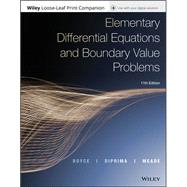
Note: Supplemental materials are not guaranteed with Rental or Used book purchases.
Purchase Benefits
What is included with this book?
Preface vii
1 Introduction 1
1.1 Some Basic Mathematical Models; Direction Fields 1
1.2 Solutions of Some Differential Equations 9
1.3 Classification of Differential Equations 16
2 First-Order Differential Equations 24
2.1 Linear Differential Equations; Method of Integrating Factors 24
2.2 Separable Differential Equations 33
2.3 Modeling with First-Order Differential Equations 39
2.4 Differences Between Linear and Nonlinear Differential Equations 51
2.5 Autonomous Differential Equations and Population Dynamics 58
2.6 Exact Differential Equations and Integrating Factors 70
2.7 Numerical Approximations: Euler’s Method 76
2.8 The Existence and Uniqueness Theorem 83
2.9 First-Order Difference Equations 91
3 Second-Order Linear Differential Equations 103
3.1 Homogeneous Differential Equations with Constant Coefficients 103
3.2 Solutions of Linear Homogeneous Equations; the Wronskian 110
3.3 Complex Roots of the Characteristic Equation 120
3.4 Repeated Roots; Reduction of Order 127
3.5 Nonhomogeneous Equations; Method of Undetermined Coefficients 133
3.6 Variation of Parameters 142
3.7 Mechanical and Electrical Vibrations 147
3.8 Forced Periodic Vibrations 159
4 Higher-Order Linear Differential Equations 169
4.1 General Theory of nth Order Linear Differential Equations 169
4.2 Homogeneous Differential Equations with Constant Coefficients 174
4.3 The Method of Undetermined Coefficients 181
4.4 The Method of Variation of Parameters 185
5 Series Solutions of Second-Order Linear Equations 189
5.1 Review of Power Series 189
5.2 Series Solutions Near an Ordinary Point, Part I 195
5.3 Series Solutions Near an Ordinary Point, Part II 205
5.4 Euler Equations; Regular Singular Points 211
5.5 Series Solutions Near a Regular Singular Point, Part I 219
5.6 Series Solutions Near a Regular Singular Point, Part II 224
5.7 Bessel’s Equation 230
6 The Laplace Transform 241
6.1 Definition of the Laplace Transform 241
6.2 Solution of Initial Value Problems 248
6.3 Step Functions 257
6.4 Differential Equations with Discontinuous Forcing Functions 264
6.5 Impulse Functions 270
6.6 The Convolution Integral 275
7 Systems of First-Order Linear Equations 281
7.1 Introduction 281
7.2 Matrices 286
7.3 Systems of Linear Algebraic Equations; Linear Independence, Eigenvalues, Eigenvectors 295
7.4 Basic Theory of Systems of First-Order Linear Equations 304
7.5 Homogeneous Linear Systems with Constant Coefficients 309
7.6 Complex-Valued Eigenvalues 319
7.7 Fundamental Matrices 329
7.8 Repeated Eigenvalues 337
7.9 Nonhomogeneous Linear Systems 345
8 Numerical Methods 354
8.1 The Euler or Tangent Line Method 354
8.2 Improvements on the Euler Method 363
8.3 The Runge-Kutta Method 367
8.4 Multistep Methods 371
8.5 Systems of First-Order Equations 376
8.6 More on Errors; Stability 378
9 Nonlinear Differential Equations and Stability 388
9.1 The Phase Plane: Linear Systems 388
9.2 Autonomous Systems and Stability 398
9.3 Locally Linear Systems 407
9.4 Competing Species 417
9.5 Predator-Prey Equations 428
9.6 Liapunov’s Second Method 435
9.7 Periodic Solutions and Limit Cycles 444
9.8 Chaos and Strange Attractors: The Lorenz Equations 454
10 Partial Differential Equations and Fourier Series 463
10.1 Two-Point Boundary Value Problems 463
10.2 Fourier Series 469
10.3 The Fourier Convergence Theorem 477
10.4 Even and Odd Functions 482
10.5 Separation of Variables; Heat Conduction in a Rod 488
10.6 Other Heat Conduction Problems 496
10.7 The Wave Equation: Vibrations of an Elastic String 504
10.8 Laplace's Equation 514
11 Boundary Value Problems and Sturm-Liouville Theory 529
11.1 The Occurrence of Two-Point Boundary Value Problems 529
11.2 Sturm-Liouville Boundary Value Problems 535
11.3 Nonhomogeneous Boundary Value Problems 545
11.4 Singular Sturm-Liouville Problems 556
11.5 Further Remarks on the Method of Separation of Variables: A Bessel Series Expansion 562
11.6 Series of Orthogonal Functions: Mean Convergence 566
Answers to Problems 573
Index 608
The New copy of this book will include any supplemental materials advertised. Please check the title of the book to determine if it should include any access cards, study guides, lab manuals, CDs, etc.
The Used, Rental and eBook copies of this book are not guaranteed to include any supplemental materials. Typically, only the book itself is included. This is true even if the title states it includes any access cards, study guides, lab manuals, CDs, etc.